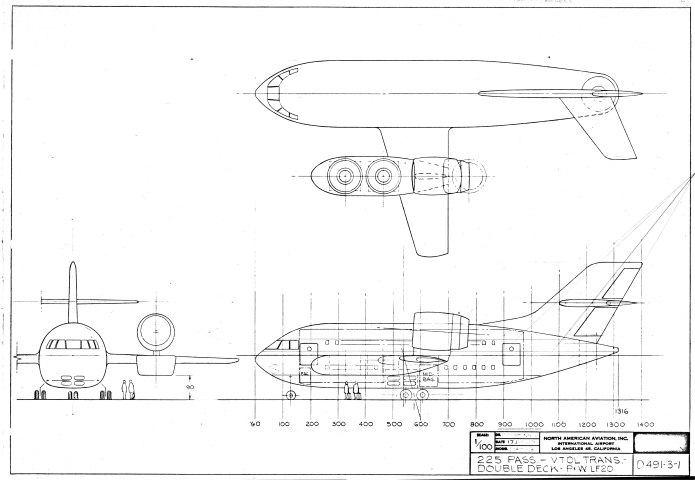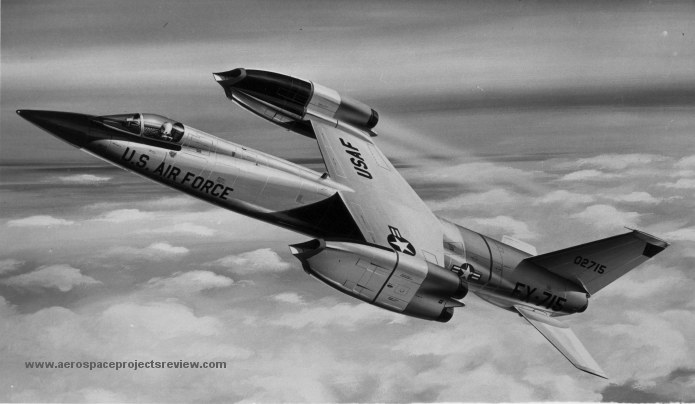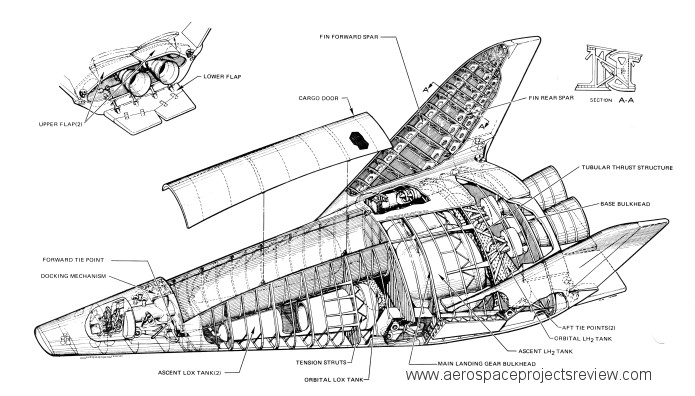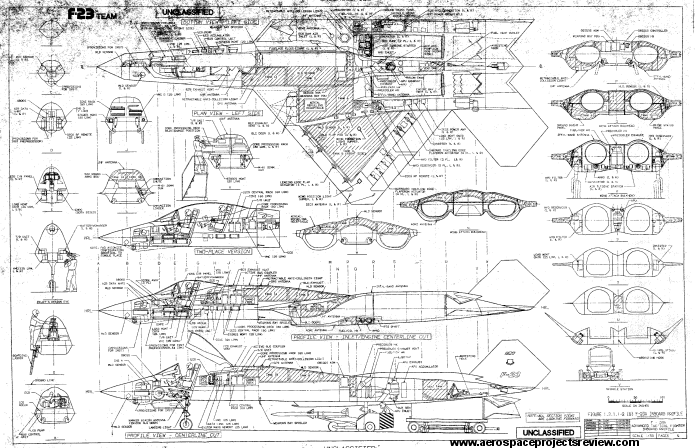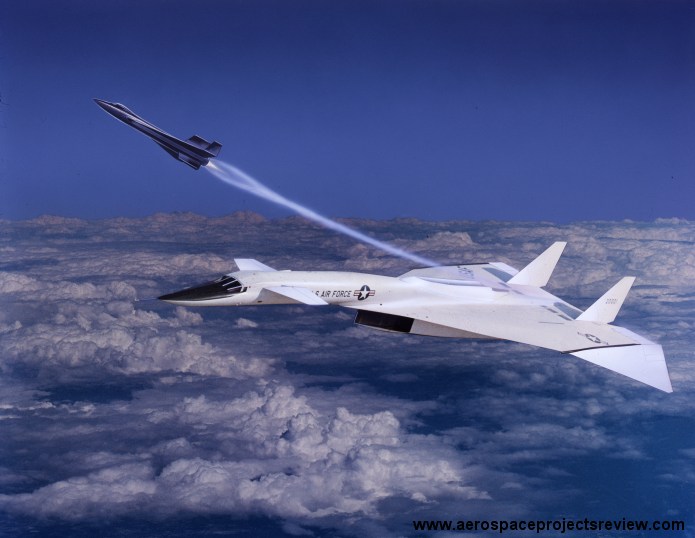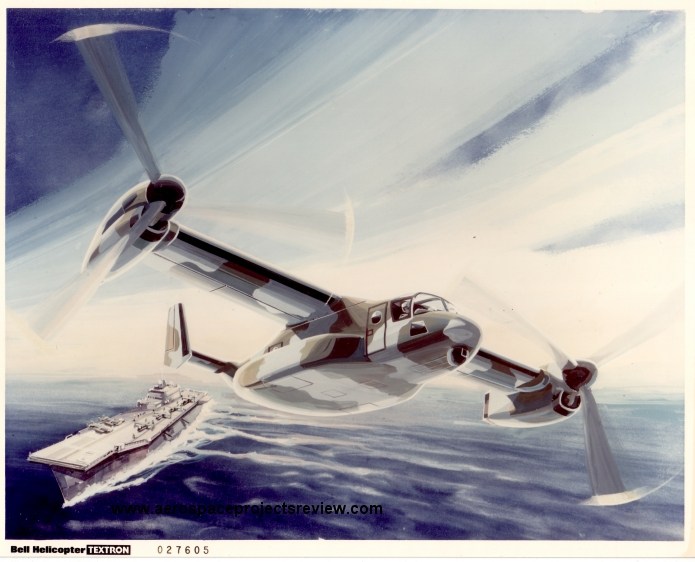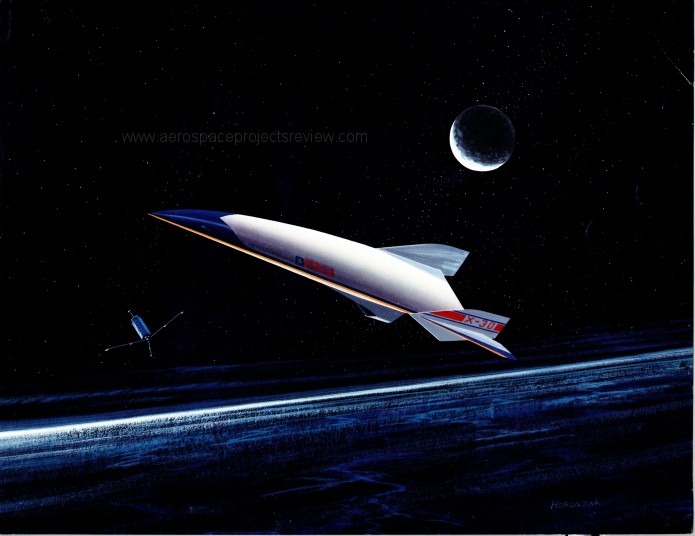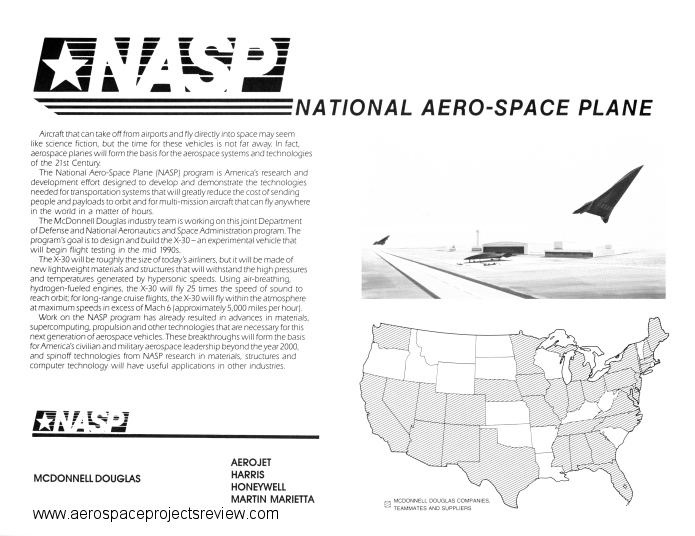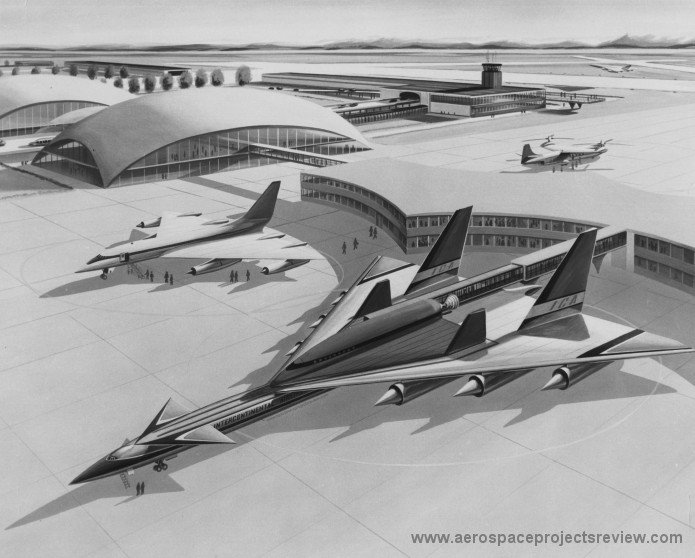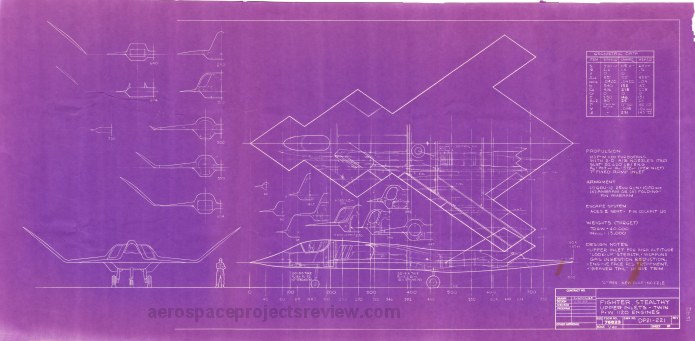A large layout drawing of a January, 1969, North American Aviation VTOL jetliner designs under contract to NASA. Note that this has a double deck, an unusual feature for a fuselage this relatively short.
A Bell Aircraft illustration of the D188A VTOL strike fighter. This design was described in detail in Article 34, available for both download and printed.
You can download a 5.5 megabyte version of this diagram; the link is HERE. To access it, you will need to enter a username and password. The username: the first word in the body of the text on page 6 of APR issue V1N4. The password: the first word in the body of the text on page 14 of the same issue. Note that both are case sensitive.
A cutaway diagram of a Boeing-Lockheed Space Shuttle concept derived from the Lockheed STAR Clipper design. This and other related concepts was covered in great detail in issue V3N2 of Aerospace Projects Review.
You can download a 1.5 megabyte version of this diagram; the link is HERE. To access it, you will need to enter a username and password. The username: the first word in the body of the text on page 8 of APR issue V3N2. The password: the first word in the body of the text on page 24 of the same issue. Note that both are case sensitive.
This design was featured in the F-23 derivatives article in the recent V3N2 issue of Aerospace Projects Review. This was Northrops plan for an operational follow-on to the YF-23, with some notable geometry changes.
You can download a 2.5 megabyte GIF file of the diagram. The link to the JPG file is HERE. To access it, you will need to enter a username and password. These are available on the first page of the Aerospace Projects Review V3N2 Addendum (available HERE) Note that both are case sensitive.
The proposed X-15A-3 was a stretched, delta-winged version intended for extended duration flight at Mach 6+. As with the X-15 and X-15A-2 versions, the plan was to launch the X-15A-3 from a B-52 underwing pylong. However, North American Aviation proposed launching it from atop a B-70 bomber. The theory was that the B-70 could get the X-15 up to around Mach 3 prior to separation, thus greatly improving the rocketplanes performance. However, launchign winged vehicles from the back of supersonic aircraft is non-trivially difficult… as the M-21/D-21 crash demonstrated.
The X-15A-3 shown here is an early design. The final version featured diamond-shaped wingtip fins.
You can download a 12 megabyte JPG file of the artwork; the link is HERE. To access it, you will need to enter a username and password. The username: the first word in the body of the text on page 3 of APR issue V2N6. The password: the first word in the body of the text on page 4 of the same issue. Note that both are case sensitive.
Dates from the late 80’s or early 90’s.
You can download a 3 megabyte JPG file. The link to the JPG file is HERE. To access it, you will need to enter a username and password. The username: the first word in the body of the text on page 13 of APR issue V3N1. The password: the first word in the body of the text on page 21 of the same issue. Note that both are case sensitive.
This card shows an early (late 1980’s) McDonnell-Douglas design for NASP. A relatively fat lifting body design, this has many similarities to hypothetical “Aurora” hypersonic spyplane designs bandied about at the same time. This is not surprising… this NASP design is similar to any of a number of hypersonic configurations tested in NASA wind tunnels and shown publicly.
Note that the text on the back of the card describes a vehicle somewhat different than what NASP was supposed to be. The claim is made that the scramjets could power the vehicle Mach 25, orbital velocity… of they could allow the vehicle to cruise at Mach 6 for long range hypersonic transport. Early on in the program, the “Orient Express” was touted as a logical result of NASP work, but that quickly faded.
You can download 5.3 and 2.5 megabyte JPG files of the illustrations. The links to the JPG files are HERE and HERE. To access them, you will need to enter a username and password. The username: the first word in the body of the text on page 5 of APR issue V1N1. The password: the first word in the body of the text on page 11 of the same issue. Note that both are case sensitive.
In 1960, Bell Aircraft released several paintings depicting a two-stage hypersonic passenger transport. The first stage was a multi-engined supersonic jet of fairly conventional configuration (though with very large 50,000 lb-thrust turboramjet engines), carrying on its back a rocket-powered second stage. The second stage was clearly influenced by Bell work on the Dyna Soar program.
The carrier would transport the second stage to an altitude of 20 miles and 5,300 mph. After release, the second stage would boost to 40 miles and speeds up to 15,000 miles per hour, permitting travel times from Los Angeles to Paris of one hour and four minutes for the thirty passengers on board. The vehicle was intended to enter service in the 1980-1990 timeframe.
Weight for the combined vehicle at takeoff would be 750,000 pounds. Span of the booster was 150 feet, length 200 feet. It’s unclear if this was a serious engineering design or purely speculative. Paintings and a display model show some notable differences.
You can download a 3 megabyte JPG file of the artwork; the link is HERE. To access it, you will need to enter a username and password. The username: the first word in the body of the text on page 6 of APR issue V1N3. The password: the first word in the body of the text on page 23 of the same issue. Note that both are case sensitive.
This design was featured in the F-23 derivatives article in the recent V3N2 issue of Aerospace Projects Review. This was an attempt by Northrop to adapt F-23 design elements to a Naval role, carrier-capable.
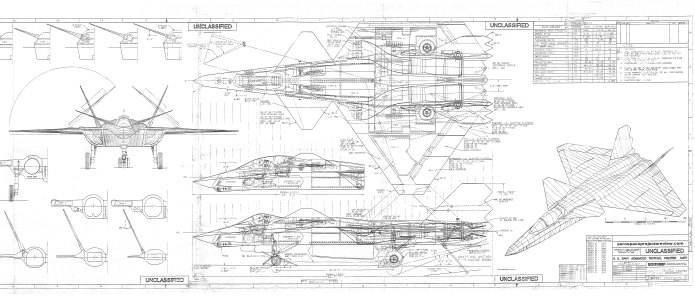 You can download a 1.4 megabyte GIF file of the diagram. The link to the JPG file is HERE. To access it, you will need to enter a username and password. These are available on the first page of the Aerospace Projects Review V3N2 Addendum (available HERE) Note that both are case sensitive.
You can download a 1.4 megabyte GIF file of the diagram. The link to the JPG file is HERE. To access it, you will need to enter a username and password. These are available on the first page of the Aerospace Projects Review V3N2 Addendum (available HERE) Note that both are case sensitive.
This design was featured in the F-23 derivatives article in the recent V3N2 issue of Aerospace Projects Review. The unusual geometry was an attempt as radar reflection shaping.
You can download a 15.5 megabyte version of this diagram; the link is HERE. To access it, you will need to enter a username and password. The username: the first word in the body of the text on page 8 of APR issue V3N2. The password: the first word in the body of the text on page 24 of the same issue. Note that both are case sensitive.
